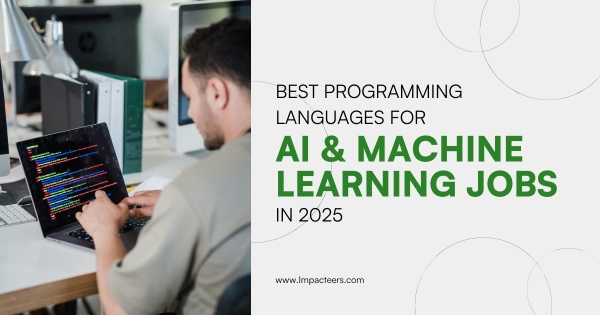If you are making a career in machine learning jobs or AI, you probably asked yourself: “In which programming language should I master first?” This is a reasonable question. After all, the tech is changing rapidly, and the equipment demanding companies in 2025 may not be the same as a few years ago.
Here’s good news: While the trend shift, some programming languages live at the core of machine learning jobs. If you get these rights, you will stand in interviews, create strong projects, and make yourself more employable in this competitive market.
Think of it in this way – closing the right language is like choosing the right vehicle for a long road trip. You can reach your destination in many ways, but the right ride makes the journey smooth.
In this guide, we will break the best programming languages for AI and ML in 2025, find out why they matter, and show you how to use them to jump their career.
Visit Us >>>> https://www.impacteers.com/home
1. Python: Still the King of Machine Learning
Let’s start with the obvious one—Python. If you’ve Googled anything about AI, you’ve already seen its name everywhere. And that’s not changing in 2025.
Why Python?
- Ease of learning – Its simple syntax makes it perfect for freshers.
- Huge libraries – TensorFlow, PyTorch, Scikit-learn, Pandas… the list goes on.
- Community support – Millions of developers share tutorials, code snippets, and solutions online.
Career Impact
If you want to land an AI internship or a full-time machine learning job, Python is practically a requirement. Most job descriptions list it as a “must-have.”
2. R: The Data Wizard
R isn’t as mainstream as Python, but when it comes to heavy-duty statistics and data visualization, it shines.
Why R?
- Data analysis – Built for statistical computing.
- Visualization tools – ggplot2 and Shiny make data storytelling powerful.
- Strong in research – Many universities and labs still rely on it.
Career Impact
If your career goal leans more toward research roles, data-heavy analysis, or academic projects, R is worth knowing. It won’t replace Python, but it complements it.
3. Java: The Enterprise Favorite
Now, let’s talk about Java. While some freshers see it as “old school,” the truth is, it’s deeply rooted in enterprise systems.
Why Java?
- Scalability – Perfect for large-scale applications.
- Cross-platform – Write once, run anywhere.
- Integration – Works smoothly with big data frameworks like Hadoop.
Career Impact
Many big companies still build AI-powered systems on Java. If you want a stable career path and the flexibility to switch between software development and machine learning jobs, Java keeps doors open.
4. C++: For the Performance-Driven
While not the friendliest language for beginners, C++ holds a strong place in AI.
Why C++?
- Speed – Excellent for performance-heavy applications.
- Control – Gives you a deeper understanding of how systems work.
- AI in gaming & robotics – Often used where performance is critical.
Career Impact
If you’re eyeing AI in robotics, autonomous vehicles, or AR/VR, C++ is a language worth investing time in.
5. Julia: The Rising Star
Julia is one of the newer languages making noise in the AI space. By 2025, it’s expected to grow even more.
Why Julia?
- High performance – Close to C++ speeds.
- Great for math – Designed for numerical analysis and computations.
- Adoption in research – Increasingly used in scientific communities.
Career Impact
Not yet a must-have for machine learning jobs, but if you want to future-proof your skills, Julia might give you a competitive edge.
6. JavaScript: AI in the Browser
Surprised to see JavaScript here? Don’t be. With the rise of web-based AI tools, JavaScript is carving out its place.
Why JavaScript?
- Web integration – AI models can run directly in browsers.
- Libraries – TensorFlow.js allows ML on the web.
- Cross-domain skills – If you know web development, it’s easier to merge AI into apps.
Career Impact
For those who see their career blending web development with machine learning, JavaScript is a must-have.
7. SQL: The Unsung Hero
Here’s the truth: before you train fancy models, you need data. And SQL is how you get it.
Why SQL?
- Data extraction – Pull insights directly from databases.
- Integration – Almost every company uses SQL somewhere in their stack.
- Easy to learn – Even non-programmers can pick it up quickly.
Career Impact
SQL alone won’t land you a machine learning role, but paired with Python or R, it makes you much more effective.
How to Choose the Right Language for You
So which language should you focus on? The answer depends on your career goals:
- Want to land machine learning jobs quickly? → Start with Python.
- Interested in research? → Add R or Julia.
- Eyeing enterprise careers? → Java will serve you well.
- Going into robotics or AR/VR? → C++ is key.
- Looking at AI for the web? → JavaScript.
Remember, you don’t need to learn them all at once. Start with one (Python is the safest bet) and expand based on your interests.
Where to Gain Practical Experience
Learning the language is step one. Step two is proving you can use it. Employers care less about certificates and more about projects.
Ways to build experience:
- Internships – Real-world experience with deadlines and teamwork.
- Open-source contributions – Collaborate on GitHub projects.
- Hackathons – Quick projects that showcase creativity.
- Freelance gigs – Even small projects can show initiative.
And here’s where Impacteers Jobs makes life easier. Instead of browsing endless generic job boards, you can find AI internships, fresher roles, and machine learning jobs all in one place—specifically curated for IT professionals. It’s a smarter way to connect your skills with real opportunities.
Challenges You’ll Face (and How to Overcome Them)
It’s not always smooth sailing. Here are common hurdles freshers hit:
- Too many choices – Feeling overwhelmed by languages and tools. Solution: Start with Python.
- Lack of projects – No portfolio to show recruiters. Solution: Do internships, contribute to open-source.
- Imposter syndrome – Thinking you’re “not good enough.” Solution: Remember, everyone starts small.
- Changing trends – Worrying about what’s “hot” in 2025. Solution: Build strong fundamentals—languages may shift, but problem-solving never goes out of style.

Conclusion
The world of AI and machine learning jobs in 2025 will be exciting, competitive, and full of opportunities. But the foundation of your career rests on one thing – choosing the right programming language to master.
Python will dominate, but depends on your goals, R, Java, C ++, Julia, JavaScript, and SQL all have their place. The trick is not to learn everything at once, but to focus on the language that aligns with the role of your dream.
And remember, skills alone are not enough. You will need projects, internships and practical risk to stand out. This is the place where platforms such as impacter jobs give you an edge, which connects you with AI Internships, Freshers’ roles and machine learning jobs ready for IT professionals.
So choose your language, start building projects, and step into confidence in the future of AI. Demand is – The only question is whether you will be ready?
About Us >>>> https://blog.impacteers.com/
FAQs
1. Which programming language is best for machine learning jobs in 2025?
Python remains the top choice for most machine learning jobs due to its simplicity and vast libraries.
2. Can I get an AI job by just knowing Python?
Yes, many entry-level AI and machine learning jobs list Python as the primary requirement. But adding SQL or R can boost your chances.
3. Is C++ still relevant for AI in 2025?
Absolutely. It’s especially valuable in fields like robotics, gaming, and systems where performance matters.
4. How important are internships for AI careers?
Internships are crucial. They give you real-world experience, teamwork exposure, and make your resume stand out.
5. Where can I find AI and machine learning jobs as a fresher?
Along with LinkedIn and company websites, platforms like Impacteers Jobs specialize in IT careers and make it easier to find the right role.




Post Comment